Clothes Make the Musical: The Costumes that Coloured Les Misérables
It’s a musical that has enjoyed worldwide acclaim on both West End and Broadway stages, and has since seen fresh success on cinema screens through Tom Hooper’s 2012 adaptation. It seems only right that a story written with such painstaking attention to detail should be showcased through costumes that have been created with a similarly perceptive eye, an eye that in this production belonged to Oscar nominated costume designer Paco Delgado.
The film adaptation of Victor Hugo’s Les Misérables, aptly and affectionately named ‘The Brick’ by devoted readers after its last word finally brings the journey to a close on page 1263, offers a different view into the tragic lives of the characters, a view that is mercilessly up close and personal. Unflattering, unforgiving and brave, the close ups that dominate this feature and capture the characters at their emotional extremes mirror their lives, and gives the audience an insight into the very seams of their character. Details in their costume that are near impossible to see on stage for its projective nature are brought quietly to the fore, and from that, those you see on screen become more than characters; they become people. This is a feat for which a costume designer rarely receives recognition, as the best costume creations are invisible.
“Costume designers are creating people – not art – not props – and not costumes for two dimensional characters.” – Deborah Nadoolman Landis, Designer
First impressions stem from the aesthetic. A character’s life story can be relayed from their wardrobe, a secret betrayed in their pockets, their status confirmed by a pair of shoes. In the same way a glance can communicate a stream of dialogue, an image in film truly can portray the depth of a thousand words. Despite that, the significance of costume in film is often overlooked, and it is perhaps the word itself that is to blame. Costume falls victim to its very own name; artificial, superficial, the word costume brings to mind fancy dress, cravats, bonnets and masquerade masks. It is make believe and fantasy. It’s possible that the sub-genre of film and television productions, ‘costume dramas’, are partly responsible for this connection, as audiences invested in this sub-genre are enjoying and are attracted to not only the story, but also the novelty of experiencing the ruffled and bustled fashions of yesteryear.
There is no escaping the visual identity of 1815 France through costumes ranging from regal to raunchy, from comedic to tragic, relaying a whole 30 years of 19th Century fashion, the story stretching from the year 1815-1848. It is, for a story decidedly bleak, alive with visual charisma. But symbolism must be presented both boldly and subtly for the subconscious to take note of the visual story that is weaved between the words, and sometimes, that facet is lost. It is easy to say that particular loss was not suffered in this striking reimagining of Les Misérables. Paying particular attention to colour, below we will unpick the costumes that deserve a second glance.
Red
Historically, red has shared a long association with war; the colour of rebellion, of defiance, of endurance and even the blood of the martyrs killed in battle. The relevance of these connotations is clear in a film such as Les Misérables, but red stands for a different cause for two particular central characters.
Jean Valjean (Hugh Jackman)
Introduced on the brink of freedom, beaten and scarred by decades in the galleys, Jean Valjean is the saint like figure that carries the weight of the entire film, and has a remarkable journey both emotionally and visually. His defining colours also share a few connections with the heartbreakingly devoted mother Fantine, from the red grip of slavery to the sanctifying whiteness of their deaths.
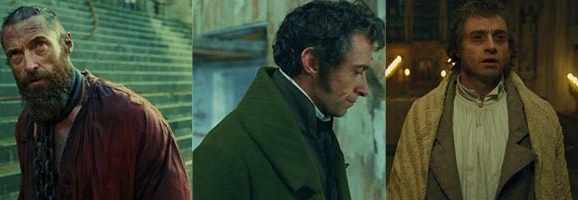
While Valjean’s appearance is rough in every manner, the make-up artists triumphantly etching two loveless decades onto his face, his bared skin exposes a sense of vulnerability, and, as he slowly redeems himself and puts to rest the past that has stripped him of all his compassion, he becomes progressively more sophisticated as the film develops. But Jean Valjean’s newfound success as Mayor doesn’t dwarf the heart of his character in a lavish wardrobe upgrade. It’s retained by the use of humble, earthy tones, modestly supporting the unfailing honesty and goodness that turns him from hating a world that, in his eyes, had always hated him.
Fantine (Anne Hathaway)
Tirelessly working for the child she put into the care of innkeepers-cum-con-artists the Thénardier’s, Fantine begins her journey as a young, love-struck woman with enviable beauty. She stands out from the hostile workers around her with her pink dress, the blue of her work robes giving her an image reminiscent of the Virgin Mary.
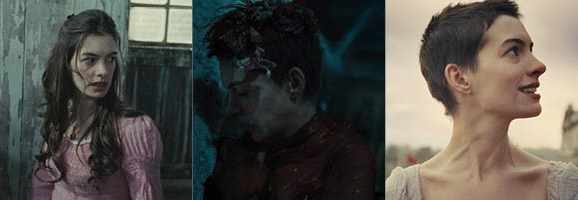
“They say that slavery had disappeared from European civilization. That is incorrect. It still exists, but now it weighs only on women, and it is called prostitution.” – Victor Hugo
Just as Jean Valjean started out this film as a slave, Fantine too is caught by the fatal vice of slavery, tragically dressed up in red as she sells herself to dockyard wretches to pay into the monstrous trick of the Thénardier’s charity.
Enjolras (Aaron Tveit)
Enjolras is a character whose lifeblood is revolution, and his relationship with red has more to do with rebellion than slavery. Described as a man of war, a soldier of the democracy and yet angelic and rosy, a “charming young man, capable of being terrible”, it seems that few other colours would represent Enjolras’ charismatic and savage character as well as red. Along with the stripes of gold in one waistcoat, the subtle blue check in the other, the angular peaked lapels and the flashes of bronze buttons on his jackets, visually he is lush, captivating and powerful, and with the mix of rich crimson and scarlet, he perfectly personifies his impassioned line, ‘red, the blood of angry men’.
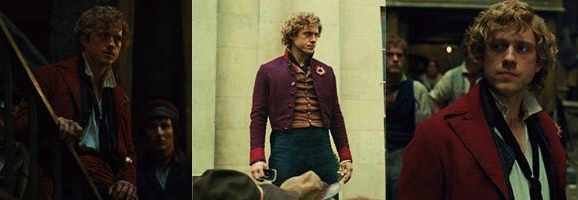
The chief of the doomed student group Les Amis de L’ABC, one of Hugo’s many intricate little puns. By the sartorial standards of 1815, his cravat slung loose around his neck, his skin exposed, would be an unusual and roguish sight, but this only adds to his incredibly romanticised image of chief and leader, rebel and revolutionary. There are subtle but poignant nods to the political inspirations that drove Enjolras’ ideals, a portrait of Robespierre, a prominent democratic figure in the French Revolution exists showing very similar fashion.
The black of his cravat is a subtle and solemn reminder of his mortality, the inevitability of his death, the martyrdom to which he is condemned that to him seems right, just and good. As his devoted friend’s deaths precede his, the red of his jacket, of the scarf that serves as a cummerbund, of the flag he holds fast until he is killed, symbolises the blood of the barricade, the blood that, immediately after Enjolras’ death, we see awash across the streets of Paris.
The Thénardiers (Helena Bonham-Carter, Sacha Baron Cohen)
These are characters that make their living from disguise, and thus they are never seen in the same get up twice, and the extravagance of their costume adequately matches that of their nerve as con artists. In both the stage production and the film they are played up to serve some well needed comedic relief, a wayward twinkle that is swallowed by their cruelty in the book.
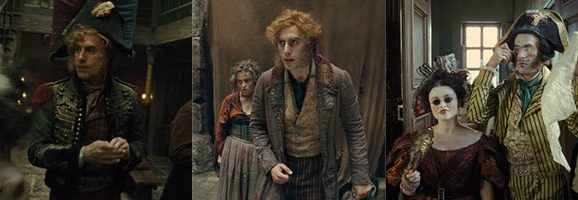
“When you normally approach a period movie, there is mostly the intention of reproducing reality with a lot of accuracy. Because this is a musical, and that is an unreal situation in life, we had to put some fantasy into it. We knew that we had to walk that line of reality and fantasy.” – Paco Delgado
Mr. Thénardier has something of a pirate about him with his shabby Captain’s uniform and their costume becomes more ragged as the film moves on before a final, spectacular stint. In their last desperate bid to come out on top, Mme. Thénardier is dowsed in that familiar colour red, the colour of the slave and the rebel. As the crooked wife of a thief she is enslaved, knowing nothing but deceit, by her tangle of treachery, the only cause in her rebellion being to cheat and steal her way to the top of a very wicked pile.
Blue
Combeferre (Killian Donnelly)
Combeferre, guide and confidant to Enjolras, claims a fair amount of screen time, although his interactions with the other students were played down to accommodate a friendship between Enjolras and Marius (Eddie Redmayne). His character serves to ‘complement and rectify’ the impassioned Enjolras, and is chiefly concerned with education, contemplation and philosophical progression. A scholar of open mind, his sincerity is represented by the deeper, more serious shade of blue of his frock coat.
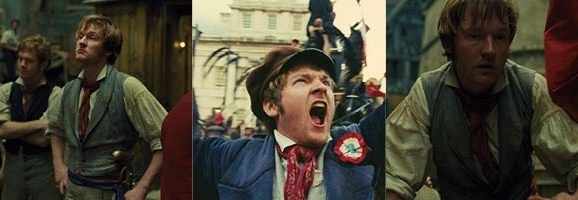
He is frequently associated with the sky, with light and with the dawn, and, seen throughout the film wearing various shades of blue, this goes to explain the decision for a muted, tranquil colour palette. He is, essentially, a personification of a more measured, contemplative Enjolras, but for all his character’s gentleness, that ever present dash of patriotic red is seen in his cravat, reminding us that the fighting streak we only get to glimpse in flashes of anger during protests still lives in this tender revolutionary.
“Combeferre … had only time to cast a glance to heaven when he expired.”
Taking a more melancholic view of the use of blue, a little foreshadowing could be at play with his death, a death ill fittingly violent for such a humane character, where he is for a final time, linked with the sky.
Marius (Eddie Redmayne)
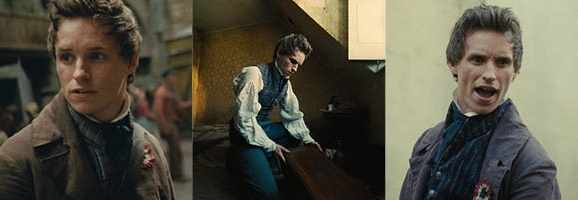
Marius’ costume effectively illustrates the conflicts of his character through both the choices of material and colour. He is, as we are shown through some quick clashes with his grandfather, from a very wealthy background, a fact he is trying to distance himself from in favour of his new life alongside Les Amis fighting for the rights of the people. But without those scenes of verbal conflict his costume would still betray this character’s internal struggle. He wears his shame at being anchored down by an upper class background in the form of a dull and worn overcoat, which hides his distinctively plush and expensive waistcoat and cravat, both of rich and respectable blues, and the presence of this flash of wealth reveals that he hasn’t yet fully rejected his background and consequently his relationship with his grandfather.
Green
Grantaire (George Blagden)
It would be an injustice to omit George Blagden’s beautifully modest portrayal of the rejected, drunken cynic Grantaire. Although the relationship between Grantaire and Enjolras is understated, it is undoubtedly significant, struggling beneath the surface until it comes to its heroically tragic end. Green defines Grantaire the same way that Enjolras personifies red, and it was no mistake when he appeared in the café Musain wearing bottle green.
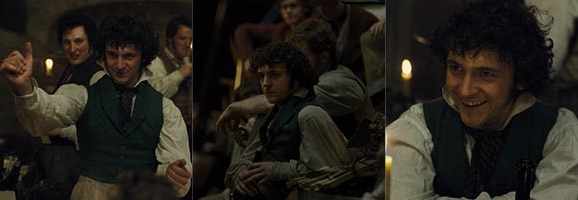
“A sceptic who adheres to a believer is as simple as the laws of complementary colours.”
The use of complementary colours is the simplest way of connecting two characters destined to complete each other. However, while the term complementary implies a positive and harmonious relationship between the colours, it in fact describes the way in which two colours are of direct chromatic contrast to each other, which communicates a great deal about the dynamic between these two strong-minded characters. Grantaire, ‘harshly treated by Enjolras, roughly repulsed,’ is the doubt to Enjolras’ conviction, the apathy to his passion, the dark to Enjolras’ light. He frustrates Enjolras, debases his cause, and yet ultimately he proves himself in death. When lights of complementary colours are mixed, they connect and produce white light, and although a loose interpretation, death is coloured white throughout Les Misérables, and it is only at the moment of mortality that Enjolras’ red and Grantaire’s green come together as one.
Éponine and Cosette (Samantha Barks, Amanda Seyfried)
Éponine and Cosette, two of the few female characters in Les Misérables, grow up together in opposition, Éponine her mother’s princess, Cosette her mother’s slave, Éponine adored, Cosette neglected, rich and poor, daughter and orphan. Those familiar with the story will know that the fortunes of these two women switch, and while their fates are set very much apart, there are still threads that keep them together.
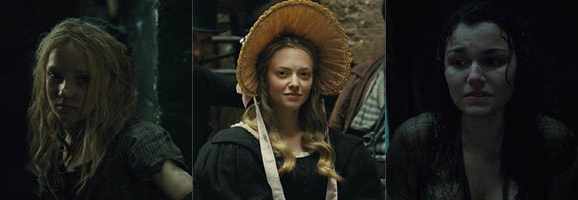
Their costumes almost swap bodies as the film progresses; the little bonnet of young Éponine’s is seen later, halo-like, on Cosette; the ragged fabric that poorly clothes Cosette clothes Éponine in an almost identical ensemble as she roams the lonely streets of Paris.
Just from looking at these collections of costumes alone it is clear to see why this rendition of the colossal 19th Century novel has enjoyed its fair share of triumphs. When such detail is woven amongst the larger than life sets, the dazzling performances and striking cinematography, costume can become what it is rightly meant to be, a character, a life, and a story of its own.
What do you think? Leave a comment.











Absolutely fantastic article! So in-depth and insightful – you’re obviously extremely knowledgeable about the brick and its adaptations, and I love your writing style; it’s entertaining, easy to read, and full of flair. I learnt so much that I hadn’t realised before, and you really convey how important such an over-looked aspect of cinema is.
Paco Delgado is a genius. All costumes are wonderful, very flattering and well suited to each actors role and body shape – very well thought out. And a very well written post, enjoyed reading it.
Thank you! There are some really great videos with Delgado and the make-up team about what thoughts went into the costumes, and also some of the sets. Definitely worth a watch.
I made some buttons for the prod. company and I was informed they were used on Anne Hathaway’s Fantine costume.
Unrecognized work.
What gorgeous designs.
I love this! The musical itself is extraordinary on the basis of the score alone, but as you’ve shown, the external details like costume are what really evoke the revolutionary setting. I remember reading that, in the 25th anniversary production of Les Mis, Alfie Boe’s Valjean wore his convict socks throughout the show even after escaping parole: the life he tried to leave behind was, in the end, always on display.
These costumes look fantastic! Although I still miss the iconic hats on Eponine and Gavroche 😀 but i can understand the choice to change it.
I love Éponine’s costumes! Samantha Barks is absolutely beautiful.
I love this article, costuming is often overlooked in discussion!
Insightful writeup, thank you!
This is a really fantastic article that makes a case for studying the formal aspects of film. I wasn’t the biggest fan of this particular film, but your passionate, insightful study makes me want to give it another chance with the eye for detail you demonstrate here.
Great observations.
Great insight into the costume choices made within the production 🙂 It’s nice to see how effective and powerful the right choice of colours can have on the overall production. I loved Les Mis so much!! And the costumes were so accurate and complementary of the original musical (and beautiful of course). Really enjoyed this article 🙂
Great article! Through precise examples, you demonstrate the importance of costume design in the film industry, an area often dismissed or forgotten by critics and audiences.I especially enjoyed your detailed anyalysis of colours. A lovely read
Interesting article! I seldom pay attention to the usage of colour in clothes, but this is pretty inspiring in making me pay more attention next time. Good job!
Fantastic analysis! I never think actively about costume but it absolutely makes a huge difference in how I see films. Although, you could put Cosette in literal angel wings and I still wouldn’t enjoy her presence. The costuming of Eponine in this film was especially on target, I believe.
Lois, this is one of the most intrepid discussions on the nature and importance of costume design I have ever read. Your attention to detail ABOUT attention to detail is both stunning as it is subtly apparent the more and more I read. After the film, I admit I was more interested in the props and the use of both the tangible, and the CGI elements blended into the film. Your essay helped illuminate the thing many of us, or at least myself, take for granted: that proper costume design allows for the willful suspension of disbelief, while reinforce all of the nuances of Hugo’s epic. Bravo.
Wow, thank you so much! I am so glad you enjoyed it. It means the world! There is so much to talk about when looking at this film alone, it was hard just to concentrate on the costumes…